Co-creating pedagogically informed games for data literacy
Co-creación pedagógica de juegos para la alfabetización en datos
https://doi.org/10.4438/1988-592X-RE-2024-405-627
Linda Castañeda
https://orcid.org/0000-0002-1055-9241
Facultad de Educación. Universidad de Murcia
Sylvester Arnab
https://orcid.org/0000-0002-4939-7382
Centre for Postdigital Cultures, Coventry University
Gemma Tur
https://orcid.org/0000-0003-4508-6808
Universitat de les Illes Balears
Fride Klykken
https://orcid.org/0000-0003-4070-3782
Centre for the Science of Learning & Technology (SLATE). University of Bergen
Barbara Wasson
https://orcid.org/0000-0003-4897-1394
Centre for the Science of Learning & Technology (SLATE). University of Bergen
Inmaculada Haba-Ortuño
https://orcid.org/0000-0002-0712-8619
Universidad de Murcia
Ruth Maloszek
https://orcid.org/0009-0009-4457-216X
FAU Chair of Educational Science
Barbara de Benito-Crosetti
https://orcid.org/0000-0002-5868-7920
Universitat de les Illes Balears
Abstract
This article explores the co-creation of educational games for data literacy in the framework of the DALI project. The games have been designed for the development of basic data literacy for citizenship and are aimed at young and older adults in non-formal contexts. The work presented here addresses the phases and strategies of co-design, highlighting their importance in the development of educational games, recognising playful learning methods as valuable tools in education that allow cultural expression, creativity, and exploration, while requiring a balance between playful and educational objectives. Co-creation in the framework of the DALI project follows a research-based design process with multidisciplinary teams (education, learning design and game science), and takes as fundamental conceptual elements of play-based learning and the principles of connected learning, combining them through the structure of the analysis framework and activity-centred design (ACAD framework). The paper details the five phases of work and highlights the importance of generating a solid pedagogical and conceptual base to scaffold the co-creation process, as well as a methodological superstructure that provides context and solidity to the playful proposal, in this case called Game Based Networked Learning Strategy (GBNLS). The paper emphasises the complexity of co-creation approaches, and the value of the tools and strategies used, highlighting the relevance of the ideas and methodologies used in this part of the DALI project for other teams working on similar strategies.
Keywords: co-creation, educational games, data literacy, DALI project, pedagogical principles, multidisciplinary collaboration.
Resumen
Este artículo explora la cocreación de juegos educativos para la alfabetización en datos, en el marco del proyecto DALI. Los juegos han sido diseñados para el desarrollo de la competencia básica en datos para la ciudadanía y están dirigidos a adultos jóvenes y mayores, en contextos no-formales. El trabajo que se presenta aborda las fases y estrategias de codiseño, destacando su importancia en el desarrollo de juegos educativos, reconociendo a los métodos de aprendizaje lúdico como herramientas valiosas en la educación que permiten la expresión cultural, la creatividad y la exploración, al tiempo que requieren un equilibrio entre los objetivos lúdicos y educativos. La cocreación en el marco del proyecto DALI sigue un proceso de investigación basada en el diseño con equipos multidisciplinares (educación, diseño del aprendizaje y ciencia de juegos), y toma como elementos conceptuales fundamentales los propios del aprendizaje basado en el juego y los principios del aprendizaje conectado, combinándolos a través de la estructura del marco de análisis y el diseño centrado en la actividad (marco ACAD). Se detallan en el trabajo las cinco fases de trabajo y se destaca la importancia de la generación de una base pedagógica y conceptual sólida que sirva de andamiaje al proceso de cocreación, además de una supraestructura metodológica que proporciona contexto y solidez a la propuesta lúdica, en este caso llamada Estrategia Didáctica Conectada Basada en el Juego (GBNLS Game Based Networked Learning Strategy). El documento hace hincapié en la complejidad de los enfoques de cocreación y el valor de las herramientas y estrategias utilizadas, destacando la relevancia de las ideas y metodologías utilizadas en esta parte del proyecto DALI para otros equipos que trabajan en estrategias similares.
Palabras clave: co-creación;, juegos educativos, alfabetización en datos, proyecto DALI, principios pedagógicos, colaboración multidisciplinar.
Introduction
In the current educational landscape, there is a growing need for innovative approaches that cater to the changing competencies needed from adults today. Researchers and educational designers are facing the challenge of developing pedagogically engaging solutions that not only address educational goals but also tap into the subjects that highly motivate the intended learners. It is within this complex educational environment that games and playful learning approaches emerge as pivotal tools (Arnab et al., 2019; Whitton, 2018).
Games have become an increasingly pertinent medium for cultural expression and artistic creativity, serving as imaginative systems that facilitate both playfulness and exploration (Arnab et al., 2019). Designing and creating games for learning is a complex challenge as it demands the balancing of the playful aspects of games and the educational outcomes they are expected to enable. There thus needs to be an intentional mapping of the game design aspects to the pedagogical aspects to ensure that the gameplay process will facilitate the learning process, enable adaptation of the games, leading to their reusability.
Recognizing the intricacy of this design challenge, this paper aims to explore the co-creation of educational games for adults, specifically targeting the development of data competencies. This endeavour unfolds within the ambit of the Data Literacy for Citizenship (DALI) project, executed under a participatory-based research approach (Gros, 2019; Gros & Durall, 2020). DALI entails collaborative endeavours in developing, testing, and evaluating learning strategies, co-creating games, and engaging adult learners with game-based resources. The project endeavours to kindle heightened interest and participation in learning through effective outreach, guidance, and motivational strategies.
This paper elucidates five distinct design phases and elucidates the strategies and tools employed during this process. It underscores their value in the framework of educational game development and emphasizes their significance within the unique context of DALI’s experience. Comprehending the complexity of this approach is crucial, and delineating the value of each tool and strategy used in the process is pivotal. This insight is not only pertinent to the present context but also holds relevance for other teams embarking on the development of analogous strategies in the future.
The DALI project, Data Literacy, and Game-Based Learning
Data Literacy for Citizenship (DALI) is an Erasmus+ project (Strategic Partnership 2020-1-NO01-KA204-076492), aimed at empowering adults to become responsible citizens and actively engage in civic activities in a world shaped by digital advancements through the development of their data literacy. DALI focuses on adults, considering that, in addition to the impact of data on their own lives, these adults have the responsibility of overseeing how young people interact with data both at home and in educational settings. The primary target groups include young adults, general adults, and senior citizens across four countries: Germany, Norway, Spain, and the UK. External stakeholders, including non-formal learning institutions and facilitators, acted as associated partners in the project.
The project started with the development of a Conceptual Framework of Data Literacy (Figure I), the DALI Framework for Data Literacy for Citizenry (Castañeda et al., 2024). The process of creating this framework involved a three-and-a-half round Delphi study that engaged experts from diverse fields such as data, education, and literacy, across four countries. The DALI Data Literacy framework encompasses four primary elements, three of which are interconnected and sometimes overlapping: (1) Understanding Data, (2) Acting on Data, and (3) Engaging Through Data. Additionally, there is a cross-cutting element, (4) Ethics & Privacy, which permeates the other three. The DALI framework is flexible and scalable, making it suitable for adaptation across various international, organizational, and educational contexts (Castañeda et al., 2024).
FIGURE I. DALI Data literacy framework
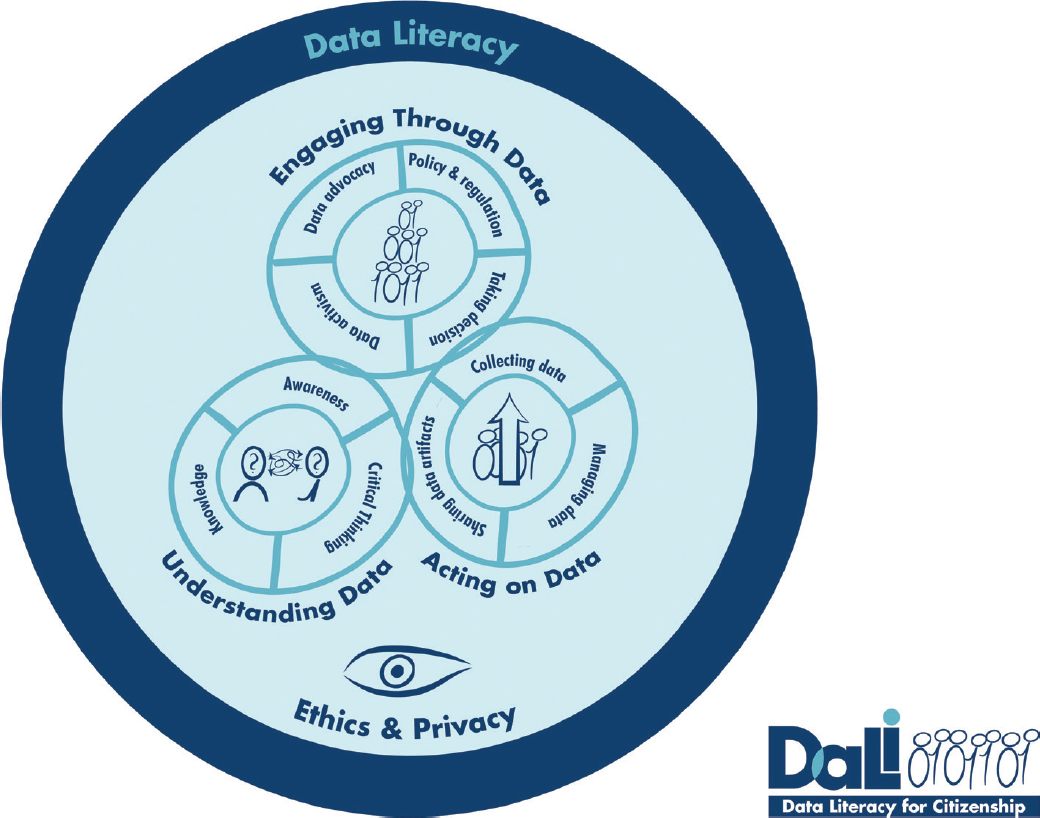
Source: Castañeda et al., 2024.
Pursuing the learning outcomes in this framework, the DALI project developed a set of ten game-based networked learning strategies (GBNLS) that cover the basic Data Literacy spectrum for each target group. Each of the ten learning strategies was designed to meet one specific learning goal. This means that the ten games addressed different learning goals and the collection altogether covered the basic Data Literacy spectrum for each target group of adult learners.
The Study: A Research-Based Design
The research-based design is a participatory design process which has been defined in four steps, that can occur as a sequence or in parallel (Gros, 2019): the context analysis, the participatory design, the product design and the prototype as hypothesis. Adapting these steps, the consortium started a process of cocreation of the GBNLS that follow five main phases:
- Firstly, in phase 1, the consortium started defining the Pedagogical approach that served as a learning design framework for the project. This approach included the data literacy framework developed within the project along with the playful approach and the networked learning background to develop the game-based pedagogical strategies. In this step, the target participants were also selected, which were mainly members of the associated partners within the project as well as target adults from these institutions and organizations.
- In phase 2, the consortium was onboarded into this pedagogical approach, where they were trained in workshops within the project. Usage scenarios were introduced mainly with the development of persona cases, informed by stakeholder mapping carried out in the project, which were then used to create the narratives of the target profiles of adult players. The content analysis of the first designs allows observing the diversity of sources, along with the awareness about designing a game for adult participants for data literacy skills.
- In Phase 3, collaborative workshops were conducted with partner teams and associate partners to co-create game-based networked learning strategies (GBNLS). During this stage, target users actively engaged in discussions about games, contributing to the development process. Initial versions of both games and GBNLS were conceptualized and tested through interactive sessions. Data collection in this phase involved distributing questionnaires to researchers, who provided insights into their co-creation experiences with others.
- In phase 4, the consortium created the game prototypes and the adaptations of the prototypes. These prototypes were viewed as hypotheses, which were tested in the field trials.
- Phase 5, which was specifically included in this process as an adaptation, encompassed the visual and material design of GBNLS (Game-Based Networked Learning Strategies) to be presented to trainers and educators.
A summary of this part of the project is detailed in the following figure (Figure II).
FIGURE II. DALI GBNLS development- Global process diagram
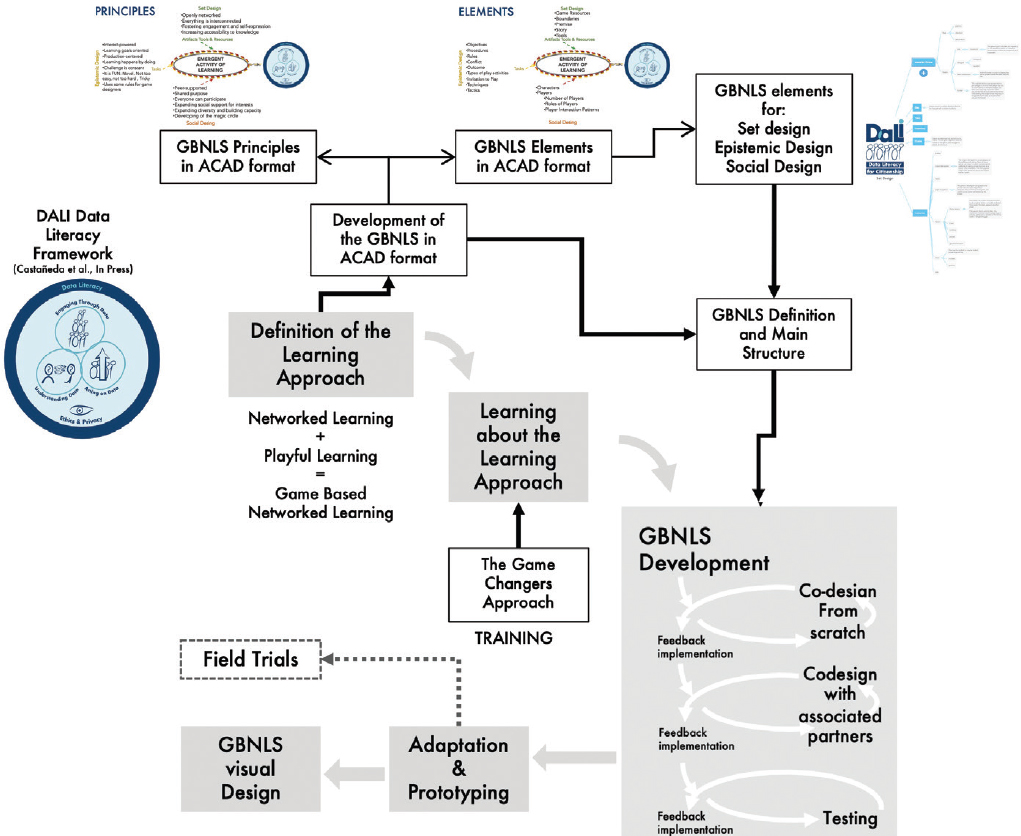
Source: Compiled by the authors.
Phase 1. Context: Definition of the Learning Approach and target participants
According to Wasson and Kirschner (2020), the contemporary technological and educational landscape has shifted the emphasis in learning design “from just the learning materials and their sequence… … to the learning environment as a whole” (Wasson & Kirschner, 2020, p. 816). This underscores the significance of moving beyond a sole focus on content or artifacts, highlighting the transformation of learning design into the crafting of a comprehensive learning experience within a specific learning environment. Therefore, the formulation of DALI learning strategies, while directed at non-formal educational contexts, must exhibit coherence on their formulation and a clearly defined pedagogical approach. This approach should prioritize the objectives of Data Literacy, as outlined by the DALI Data Literacy framework, aligning with an innovative perspective that places the adult learning vision at the forefront.
Consequently, the initial project phase focused on structuring a pedagogical approach that reconciles and structures the learning design behind the GBNLS. Recognizing the significance of expertise in education, learning design, and the science of game-based learning, a multidisciplinary approach was adopted. Two specialized teams, one from the University of Murcia (UM) specializing in education and learning design, and the other from Coventry University (CU) specializing in game science, collaborated to define the learning design elements and principles (Castañeda et al., 2022). This collaboration ensures a shared pedagogical direction within the partnership, emphasizing both overarching features and essential requirements of the project’s learning strategies.
Subsequently, the DALI pedagogical approach was formulated on the foundation of Networked Learning (NL). Adhering to the principles of NL involves viewing competence development as an emergent activity that prioritizes “foregrounding learner agency.” This perspective emphasizes expansive learning, reflexivity, and shared engagement among participants, fostering a “distinctive dynamic potential” (Networked Learning Editorial Collective (NLEC), 2020). The Activity-Centred Analysis and Design (ACAD) framework (Goodyear et al., 2021) was employed to organize the design components. Additionally, the learning approach incorporates principles from Connected Learning (CL) to create new scenarios that consider the social and material realities of the target participants, encompassing their needs, interests, and cultures (Ito et al., 2020).
The DALI pedagogical approach also integrates the concept of playful learning, leveraging games as valuable tools to observe and facilitate play in a structured manner. This approach promotes purposeful and meaningful engagement, along with actionable feedback. According to Whitton (2018) and Tekinbaş & Zimmerman (2003), three key aspects of game use in non-formal adult learning contexts are relevant to DALI: (1) The creation of a learning environment that allows learners to embrace failure; (2) the possibility of stimulating learners’ imagination enabling them to approach real-life problems from fresh perspectives and (3) the possibility of voluntary and intrinsically motivating activities through playfulness, enabling participants to enact their agency in shaping the rules, actions, and boundaries of the game space. The gaming experience itself provides a compelling context for learning and reflection (Arnab et al., 2019; Postigo Fuentes, 2021).
Grounded in playful learning, game-based learning, natural language (NL), and collaborative learning (CL), the DALI learning principles were intricately crafted utilizing the ACAD framework (refer to Goodyear et al., 2021). The primary objective was to anchor the DALI pedagogical approach in a streamlined structure, enabling the tangible embodiment of abstract project principles in physical (Set Design in ACAD), social (Social Design), and epistemic (Epistemic Design) dimensions (see Figure III).
FIGURE III. Design Principles of DALI GBNLS in the ACAD Framework Structure
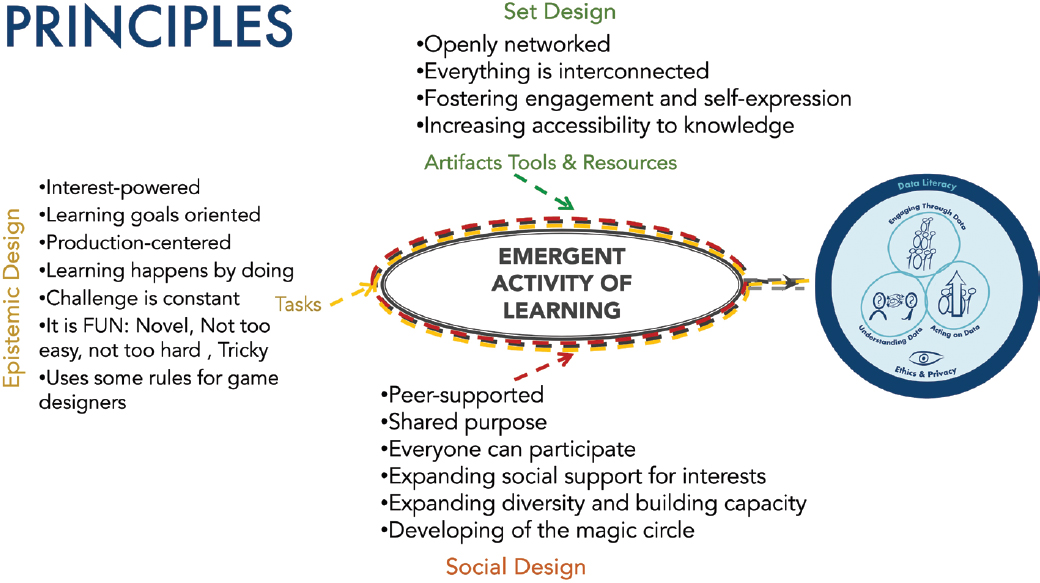
Source: Own Elaboration.
Additionally, focusing on the essential elements of game design (Arnab, 2020; Fullerton, 2019; Schell, 2008) that align with our proposed principles, we aimed to explicitly outline the design components in each category within the ACAD framework, as illustrated in Figure IV.
FIGURE IV. Design Elements of DALI GBNLS in the ACAD Framework Structure
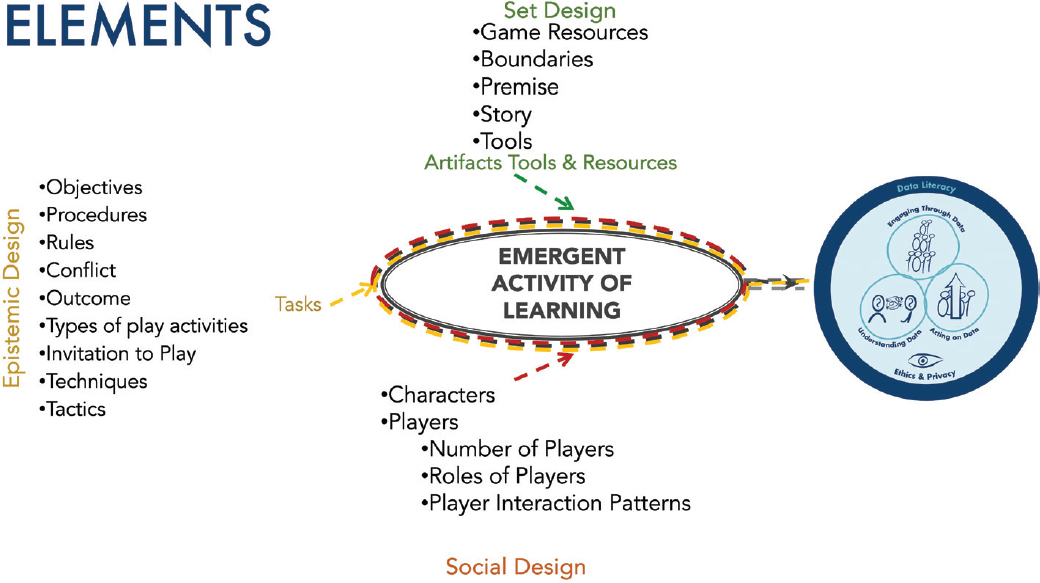
Source: Own Elaboration.
Furthermore, to facilitate the co-creation of the 10 game-based networked learning strategies (GBNLS) proposals and designs, we mapped each ACAD design element, encompassing all possible game design elements (refer to Figure V).
FIGURE V. Detail on the DALI ACAD Set Design Elements Mapping
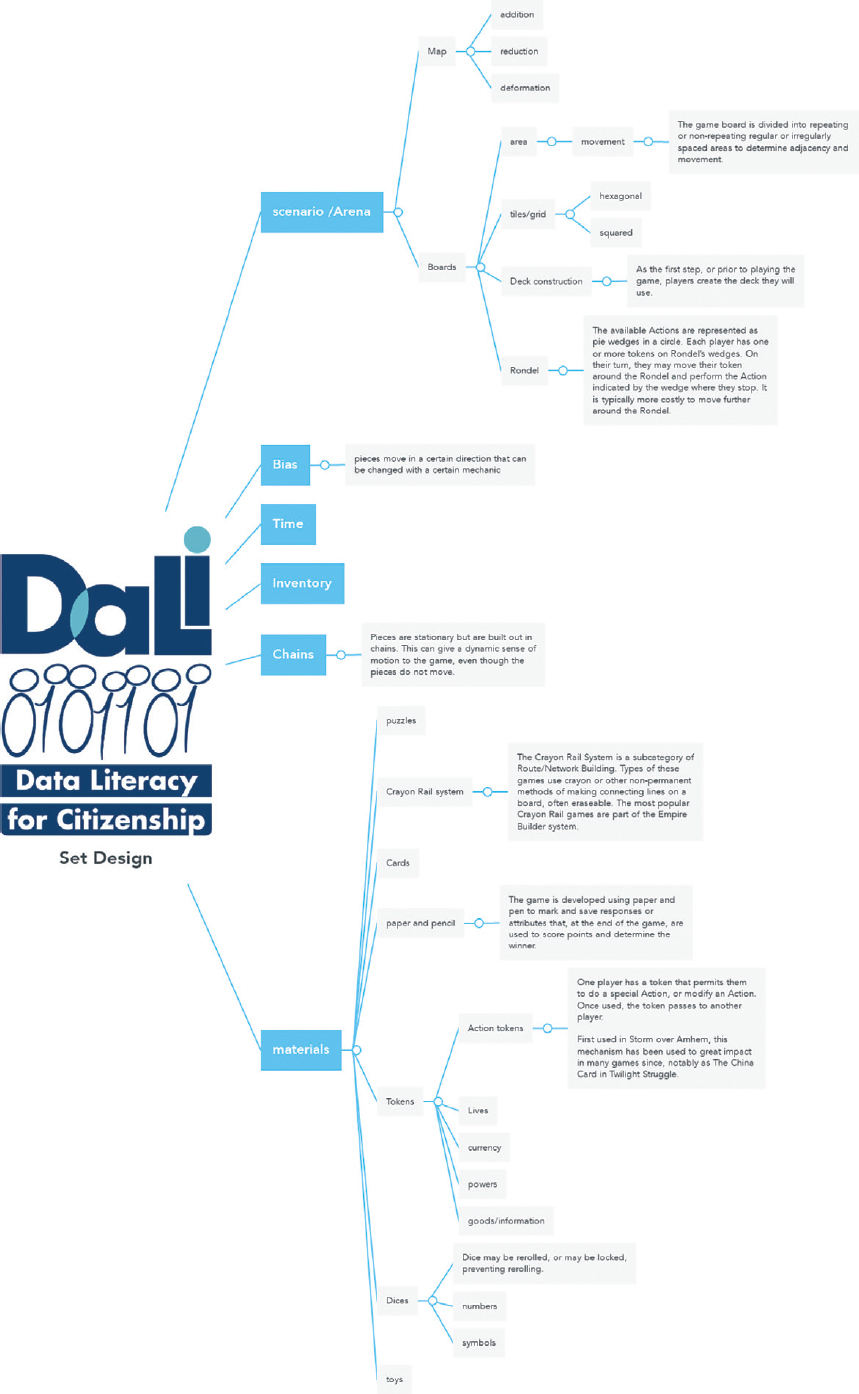
Source: Compiled by the authors.
These three maps (Set Design, Epistemic Design, and Social Design) were developed, with complete Epistemic Design and Social Design maps available in the Appendix and distributed to the entire design team.
Building on these developments, the structure of GBNLS was established. GBNLS represents the manifestation of games from a pedagogical perspective, concretizing the primary learning design elements that constitute DALI games. The final elements integrated into the GBNLS structure encompass:
The final elements included in the GBNLS structure were:
- Name of this Game-based Networked Learning Strategy
- Learning goal
– DALI framework
– Element
- Subelement
– Skill
– Ethics & Privacy
- Game inspiration
– What game?
– Rules or mechanics taken.
– Elements and materials taken.
- Name of the game (different from the GBNLS one, this is the brand name of the game)
- Epistemic Design
– The objective of the game
– Premise (story)
– Rules
– Defining objects and concepts
– Mechanics
– Indicator of learning
– Other aspects (Conflict, Tactics)
- Set Design
– Estimated time.
– Physically situation
– Scenario/Arena
– Materials
– Other aspects
- Social Design
– Number of players
– Concrete characteristics of the different target groups (Young adults, General adults, Workers, and Seniors).
- Other aspects
This comprehensive list not only streamlines the design process but also ensures the effective integration of pedagogical principles into the fabric of DALI games.
Phase 2. Training strategy for the learning approach
After the completion of the GBNLS materials and finalization of its structure, the next crucial step involved training the entire design team, comprising representatives from each partner organization, in the game co-creation. A workshop was organized for this purpose, with participation from at least two members of each partner, and was facilitated by Coventry University (CU). The workshop adhered to the Game Design Thinking strategy, a co-creation technique established by CU’s Game Changers initiative (https://gchangers.org), as illustrated in Figure VI. This methodology (The Game Changers’ methodology), detailed by Arnab et al. (2017), played a pivotal role in shaping the DALI learning strategies.
FIGURE VI. An extended Game Design Thinking Protocol based on the Game Changers approach
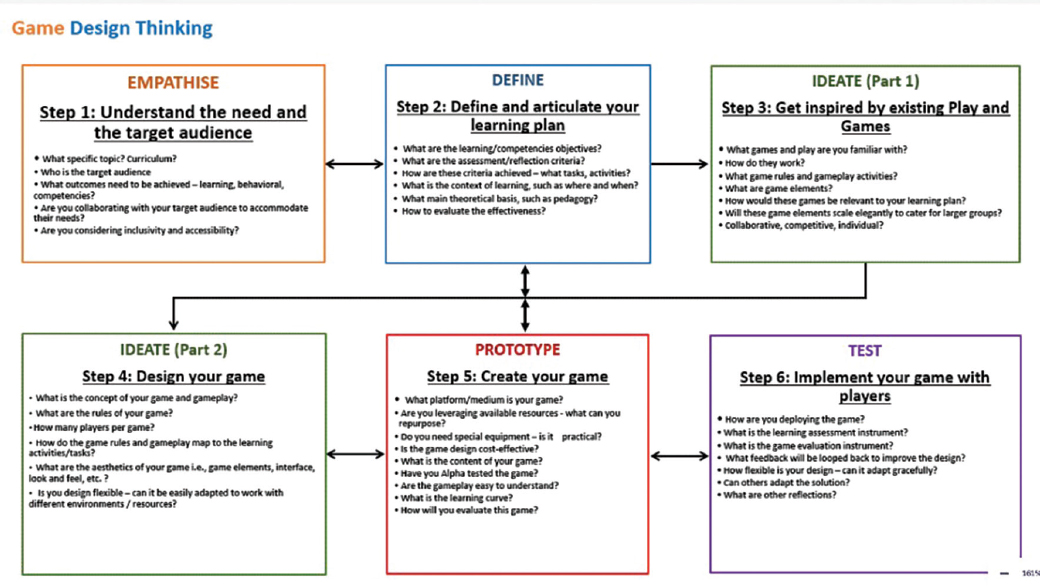
Source: Arnab et al., 2017.
The integration of design thinking with game design in the field of education has led to a unique approach known as game design thinking. This approach, as proposed by Arnab et al. (Arnab et al., 2017), facilitates the development of empathy through the game co-creation process, providing a meaningful framework for the design of game-based learning (GBL) resources. The approach follows an iterative design process (see Figure VI), drawing upon the principles of design thinking as outlined by Plattner (2011), encompassing phases such as needs assessment, ideation, prototyping, and testing. It draws inspiration from the “Game Jam Movement” (Fowler et al., 2013).
Games, with their structured rules, clear objectives, and multiple possible solutions to problems, provide an ideal context for embracing design thinking principles (Arnab et al., 2017). Partners in DALI were trained, where they practiced with the ideation and design of games that respond to the data competency framework using the mechanics, dynamics, and aesthetics of existing games. The process was guided by relevant prompts under each stage (refer to Figure VI). Through exploring multiple creative solutions based on this approach, partners can then engage their teams and stakeholders in the game design process in Phase 3.
Phase 3 Codesigning the DALI GBNLS
The primary aim of this phase was to formulate a set of engaging and adaptable learning strategies explicitly designed to promote the advancement of adult data literacy across various non-formal contexts. To achieve this, the project embraced a co-design methodology, involving the collaborative creation of GBNLS through a multidisciplinary approach (Prior et al., 2022) that harnessed combined creativity during the design process (Sanders & Stappers, 2008).
New workshops within partner teams were conducted to co-create games, employing a double strategy of cooperative inquiry and informant design (De Jans et al., 2017). The cooperative inquiry involved partners working in specialized groups, each dedicated to a specific target audience (Young adults, General adults, Workers, and Seniors). Simultaneously, an informant design strategy was implemented to incorporate external stakeholders, such as non-formal learning institutions and facilitators acting as project-associated partners, maximizing the value of their contributions (De Jans et al., 2017; Lanezki et al., 2020).
Considering these aspects, the co-design of GBNLS unfolded across three key moments:
a) GBNLS co-design from inception: International co-design teams, comprising one partner per country, utilized the Game Design Thinking strategy to develop the initial game idea.
b) Second Co-Design moment: The developed game ideas were tested in each country, with at least one partner providing feedback and suggesting improvements to the game.
c) Third Co-Design moment: In a large group setting, all members of the game design teams collaborated to design adaptations for broader applicability across different target groups.
Throughout these instances, instruments were devised to collect data on the co-created games’ quality. The first two instruments were derived from a condensed version of the UNE (Spanish Association for Standardization) 71362:2020 instrument, which evaluates the quality of digital educational materials (UNE, 2020). Surveys included questions related to criteria such as general instructions, learning impact, fun and motivation, visual design, and textual content accessibility. Initially, a quantitative approach offered a general overview of the co-creation process. Subsequently, a qualitative instrument provided detailed feedback, identifying optimal gameplay requirements. Two qualitative questions gauged partner satisfaction and gathered suggestions for necessary changes in previously defined criteria.
The three key moments are described below:
a. The GBNLS co-design from inception
Each team was given the task to design two GBNLS. Each GBNLS included as a learning objective, at least, one Data Literacy Framework sub element that was indicated in advance. The teams could include more than one sub element or level in the game but to ensure coverage of the data literacy spectrum, the one specified was compulsory and had to be the principal one. All the games created in DALI aimed to develop the basic level (level A) of the DALI Data Literacy Framework (Table I).
TABLE I. DALI Data Literacy Framework, Level A: elements and subelements
Element |
Sub-elements |
Level A |
Understanding Data |
Knowledge |
(Know) what is data and how it is created |
Awareness |
Be aware / Know about the existence of data |
|
Critical thinking |
Know that data have a value / Know data can be used for multiple purposes |
|
Acting on Data |
Collecting data |
Use external devices/apps to collect data |
Managing data |
Create, edit, and store simple file formats like .txt or .xsl to manually insert the data |
|
Sharing data artifacts |
Share and communicating data sets that already exist under ethical considerations |
|
Engaging through Data |
Policy and regulation |
Understand how society shapes data use or influences policy making |
Taking decision |
Understand civil action / Understand individual potential to use data |
|
Data activism |
Understand data activism movements and how these can change the use of that data that stakeholders do |
|
Data advocacy |
Understand your influence on peers or stakeholders to help them understand the potential and applications of data |
Source: Castañeda et al. 2024.
Collaborative understanding among stakeholders relies on the exchange of knowledge. Furthermore, the initial stage of designing a game holds significant importance as stakeholders must align on the project’s objectives, expectations from the involved parties, and the requirements of the intended audience (Prior et al., 2022).
Materials with all the elements of the Educational Approach, as well as guides and exercises, were organized in a folder, available for each team. Additionally, a MIRO board was created for each group to follow the Game Design Thinking Strategy (Figure VII).
FIGURE VII. Miro Board used for Design Group A
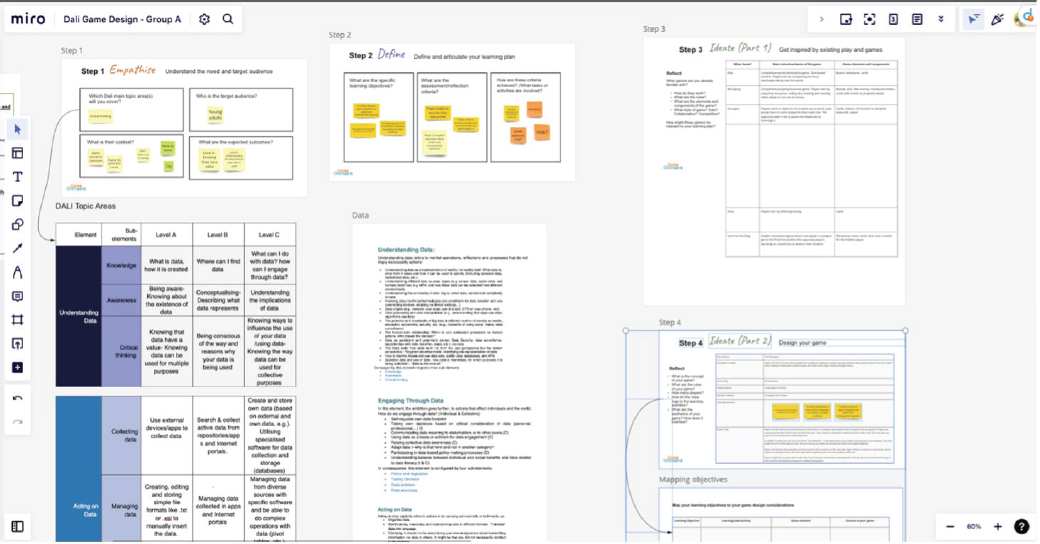
Source: Compiled by the authors.
In total, they were 5 teams of cocreation (4, one for each target group, and one team targeting intergenerational groups), that worked online using videoconference sessions (via Zoom), shared documents (via Google Drive), and email. Some of the groups centralised their work in the MIRO Boards, as can be seen in Figure VIII.
FIGURE VIII. MIRO Board for “Coup”
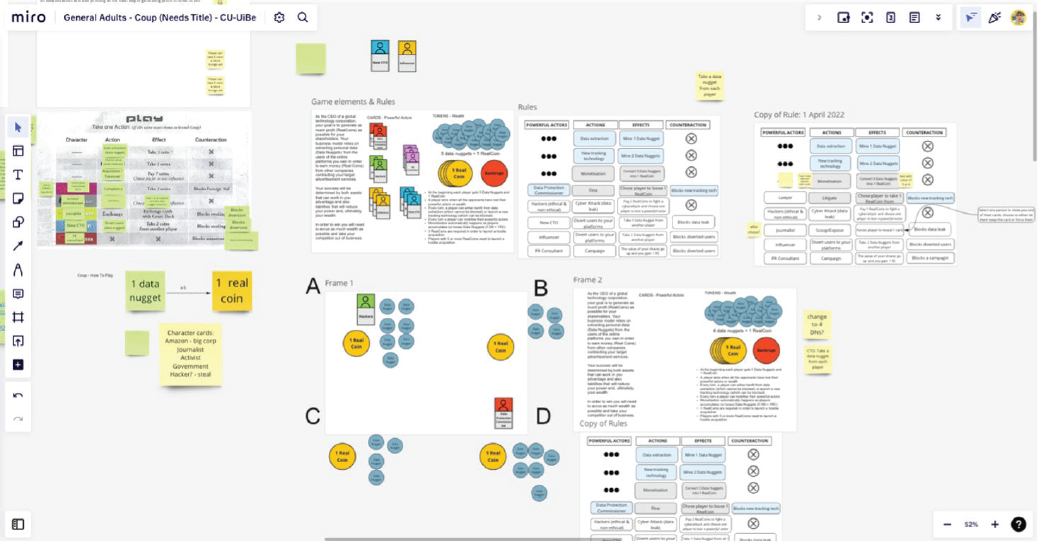
Source: Compiled by the authors.
In this phase, the collaborative teams within the partnership actively engaged in playing the games, contributing to a holistic understanding of the gaming experience. Feedback was gathered through a Likert scale, featuring seven degrees of agreement. Notably, the visual aspects received consistently high ratings for quality and clarity from the participating partners, indicating a positive reception from the outset. Nevertheless, challenges surfaced concerning the overall gameplay experience, particularly in relation to written elements found in both the instructions and game components. This insight points to areas where improvements and refinements can enhance the overall gaming experience.
b) Co-design with associated partners
In the second round of GBNLS codesign, associated partners were actively engaged in validating the games. Initial game concepts underwent testing in each participating country, involving at least one partner per country. These partners provided valuable feedback on the games and contributed by suggesting improvements, fostering a collaborative refinement process for the game designs. Validation sessions were predominantly conducted face-to-face, although some were held online for convenience.
Following the game testing with associated partners, certain games underwent readjustments, while others underwent a complete restructuring based on the insights and recommendations gathered during the validation process.
Suggestions from associated partners were related to a broad range of issues. One recurring topic was addressing challenges relating to balancing the gameplay with educational purposes. Each GBNLS should be fun and easy to play, but also promote Data Literacy and address the learning goals. A crucial aspect of each game is that it promotes play, imagination, voluntary engagement, and intrinsic motivation when they are introduced in the learning contexts. Useability, game dynamics and game mechanics were also discussed, as well as issues relating to design choices affecting the games accessibility. For instance, the final design needed to accommodate that the GNBLS were to be freely available as print-and-plays, and therefore easy to download and print. The size of the game materials and wordings of the instructions also needed to be adapted to accommodate the needs among diverse target groups. The team-based collaborative testing and evaluation processes were vital in this iterative process of continuous improvement and refinement of the functionality and overall experience of each game.
In this instance, the quality control approach was deliberately qualitative, providing teams with specific feedback to enhance subsequent stages of development. Evaluations encompassed key aspects such as the fun factor, clarity in understanding and playing, functionality of game rules and dynamics, usability and clarity of materials, visuals, texts, and instructional layout, and the appropriateness of content. The feedback, presented in open comments, was meticulously compiled into a spreadsheet. Each team received comprehensive comments pertaining to the games in which they were actively engaged. Due to space limitations, a singular comment was showcased for each dimension below:
- Fun:
– “It is fun! One improvement (which I can write more about under) is that instead of having a moderator the cards could be bigger with the Q & A on the back and then the person on the right of the one whose turn it is, reads the Q and checks the answer. This way all could be involved!”
- Easiness:
– “Overall, the game was easy to play. Some suggestions: the D-A-L-I letters don’t match with the subjects on the cards (data, context, person, activity). We think icons that suit the different categories might be better, and for clarity it is nice to print the icons on both sides of the cards. Some of the context / person cards can be activities as well, so therefore it’s easy to mix them up”.
- Functionality:
– “I think mostly they are clear, but there was some confusion on deciding the end of the game (and if we would have one, or potentially multiple winners). The rules stated first that the game ends when someone has a perfect week (implying one person will be the winner), but then it said the person that fulfils the week should notify the rest of the players so they know it is the last round (implying the round goes on until the last round is finished, which may imply several people can be the winner)”.
- Learning:
– “Yes. The game did makes us think about data”.
- Usability:
– “It was also time-consuming to cut around each card. Suggestion: Make cards straight edged, and place cards next to each other. (So that one ‘cut’ cuts between two cards)”.
- Content:
– “The language of the instruction was not so clear. I think it is because multiple steps are explained single sentences, which are really long with many commas. This confused me. Suggestion: Make short sentences. No commas. Each sentence should explain one step only”.
c) Testing
Following the integration of codesigned changes with associated partners, a brief testing phase was initiated. Each team commenced testing their respective games with individuals from their specific contexts, utilizing homemade prototypes. During these testing sessions, the games were deployed, and feedback was gathered. The associated partners were queried about their overall satisfaction with the games, and input was sought regarding recommended changes for the final version. These recommendations focused on the previously mentioned criteria, encompassing factors such as game satisfaction, usability, and suggested modifications to enhance the game experience. The following are examples of the feedback:
- Satisfaction.
– “They liked the game and had fun. Also, the fact of talking and reflecting on the data is something they valued”.
- Changes
– “We found that the rules and the game dynamics are clear in general and made only some suggestions for the instructions and cards in detail:
– explain the idea of the personal board before it is mentioned in ““Game Play”” as the ““right place””
– name examples for ““data”” in the introduction to make it clearer what is meant by data
– wording: personal player board (board) or personal game board (instructions), it should be called the same in all places.
– clarify the role of the jokers: what does ““you can keep the joker”” mean? mention that the jokers don’t count in the end.
– suggest in ““end of the game”” to check together if pairs are placed rightly, so that all players can learn from that.
– card about parking not clear, makes sense if a parking app is meant, app should be mentioned then in the card text”.
Phase 4: Adaptation and Prototyping
During Phase 4, the entire consortium engaged in the creation of game prototypes. This conclusive stage involved refining the visual design, game mechanics, and content of the games, culminating in presentations to trainers and educators. The cocreation teams collaborated on developing the visual design of the game material of each GBNLS. The visual interface of each game was also created through a reiterative co-creation process. Whilst placing data literacy and adult learning at the forefront, some practical criteria were also agreed upon. For instance, the games’ illustrations needed to be under creative commons license, and the final game-based resources had to be easy to share and print-and-play. These refined prototypes were perceived as hypotheses, subsequently subjected to field trials for validation.
After confirming the readiness of all games for their initial release, we commenced the customization process to tailor each game for diverse target groups. In a collaborative face-to-face meeting that included all design group members, the consortium introduced a dynamic needs analysis framework employing design tools known as “personas” (Jansen et al., 2020). Two personas were meticulously crafted for each target group, providing a clearer understanding of the ultimate end-users of the games (see Figure IX for an example of the personas).
FIGURE IX. Persona: Working Adult N.1
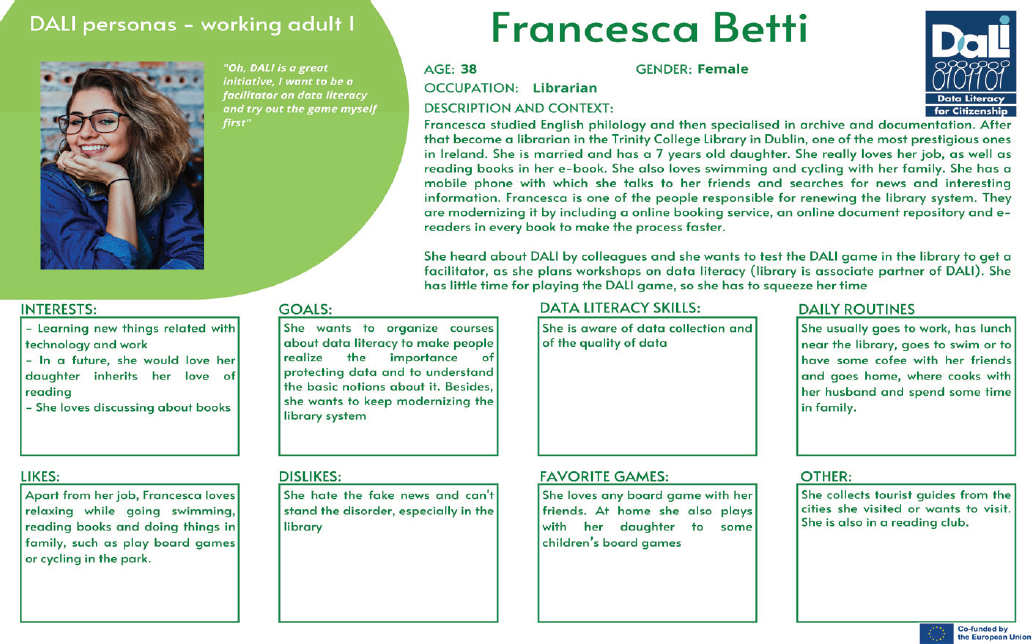
Source: Compiled by the authors.
Utilizing these personas during the meeting, the consortium organized into teams to deliberate and analyse the needs of these personas concerning games (see Figure X). Subsequently, the teams shared their conclusions in a collaborative session focused on Data Literacy.
FIGURE X. DALI Group sessions working with personas
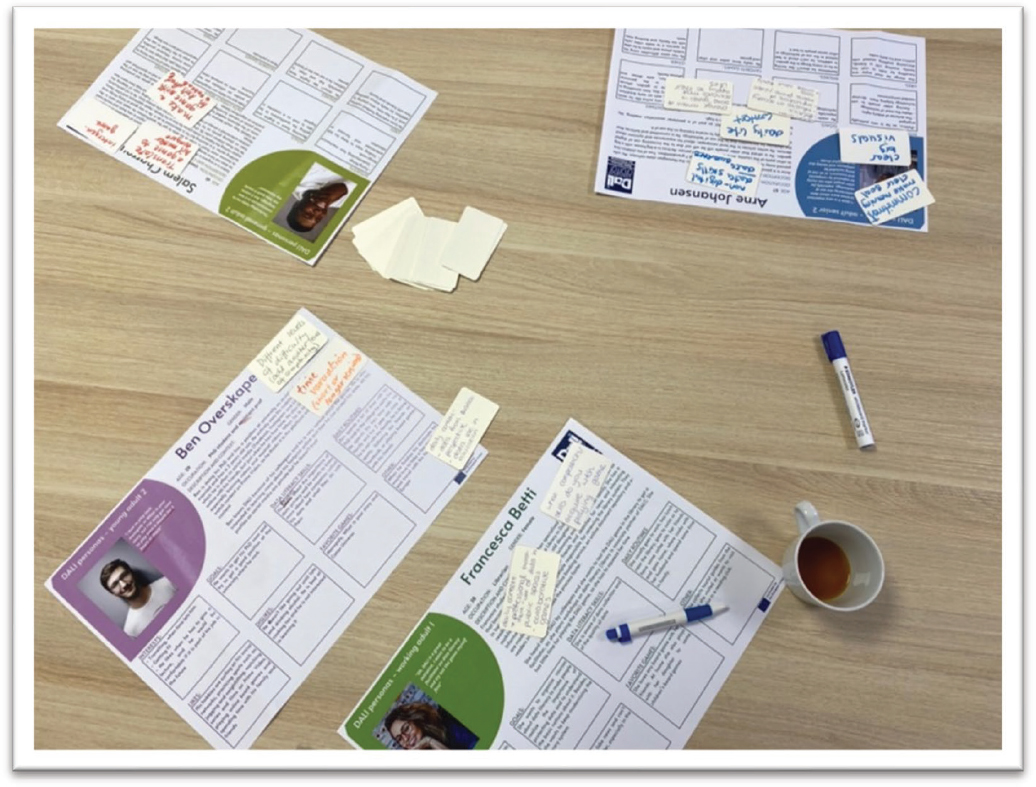
Source: Compiled by the authors.
In the shared session, based on the insights gathered, the entire group collaborated on proposals for adapting each game to the different DALI target groups.
Phase 5: GBNLS Visual Design
After finalizing the games, primed for extensive testing by end-users in the subsequent project phase, the concluding element of this design phase focuses on the visual design of the GBNLS. As emphasised earlier, while games play a crucial role in the DALI approach, the development of GBNLS has the capacity to underscore the pedagogical and educational foundations of these games. This emphasis on learning design informs educators and trainers, offering valuable insights to integrate games into meaningful learning experiences (Castañeda et al., 2022).
Drawing on the prototyped versions of the games, the GBNLS underwent refinement, and the visual design was meticulously curated by CU (refer to Figure XI). These refined GBNLS were then organized into a handbook tailored for facilitators. Furthermore, a guide for facilitators was created, with indications and recommendations for carrying out play sessions.
FIGURE XI. Game of Phones GBNLS design
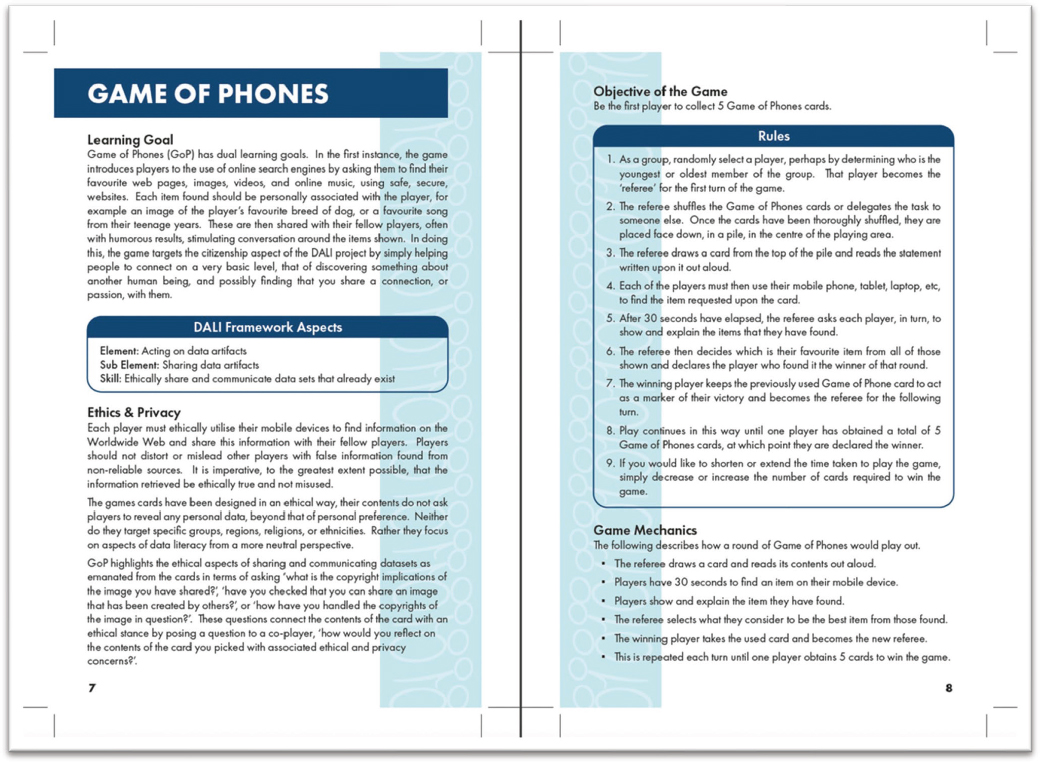
Source: Game of Phones GBNLS in DALI Handbook (https://toolkit.dalicitizens.eu/for-facilitators).
Conclusions
Acknowledging the inherent complexity of designing educational games for adults, this paper seeks to delve into the co-creation process within the context of the Data Literacy for Citizenship (DALI) project for the design of educational games for adults. Addressing the intricate processes of designing learning games, a participatory approach is adopted, which is aligned with current trends for game design (Arnab et al., 2019; Gros, 2019; Prior et al., 2022).
The DALI project, conducted as participatory research, encourages collaborative development, testing and evaluation of learning strategies, the co-creation of games and the engagement of adult learners with game-based resources, and the process of development outlined in the previous sections highlights several characteristic features that emerge as particularly interesting:
- Multidisciplinary approach: The project adopts a multidisciplinary approach, with specialized teams in education and learning design as well as game learning science working together. This collaborative effort ensures a comprehensive understanding and integration of expertise from different fields, which can lead to a well-rounded and effective learning approach (Prior et al., 2022).
- Pedagogical direction: The partnership ensures that everyone involved in the project follows the same pedagogical direction by defining the learning design elements and principles. This alignment promotes consistency and coherence in the development of learning strategies and educational experiences (Bartolomé et al., 2018; Castañeda & Selwyn, 2018).
- Networked Learning and Connected Learning: The DALI approach is based on principles of networked learning and connected learning. These approaches emphasize learner agency, reflexivity, shared engagement, and consideration of social and material realities. By incorporating these principles, the project aims to create learning experiences that are relevant, engaging, and culturally sensitive (Ito et al., 2020; Networked Learning Editorial Collective (NLEC), 2020).
- Value of games in learning: The text highlights the value of games to promote play, imagination, voluntary engagement, and intrinsic motivation in learning contexts. Games provide a structured environment that allows learners to embrace failure, approach real-life problems from fresh perspectives, and actively shape the game space. The use of games can enhance learning experiences and provide actionable feedback (Agbo et al., 2021; Paraskeva et al., 2010).
- Game Design Thinking: The project utilizes the Game Design Thinking strategy, which integrates design thinking principles with game design. This approach facilitates empathy, ideation, prototyping, and testing in the development of game-based learning resources. It provides a meaningful framework for the design of engaging and effective learning experiences (Arnab et al., 2019, 2019; Lanezki et al., 2020).
- Co-design and collaboration: The project adopts a co-design approach, involving multiple partners and stakeholders in the design process. Through cooperative inquiry and informant design strategies, the project maximizes the value of contributions from diverse perspectives. This collaborative work approach enhances creativity and ensures the development of playful and flexible learning strategies (Gros & Durall, 2020; Sanders & Stappers, 2008).
- Iterative design process: The project follows an iterative design process, involving multiple phases such as needs assessment, ideation, prototyping, and testing. This iterative approach allows for continuous improvement and refinement of the game-based networked learning strategies (Agbo et al., 2021; Lanezki et al., 2020) The quality control and criteria based on the 71362:2020 UNE norm (UNE, 2020) allowed obtaining concrete and efficient feedback for further improvement within the iterative design process.
- Participatory design: from game concept ideation through to the design of the gameplay mechanics, dynamics, and aesthetics. Building on the preceding contemplation of co-design and collaboration, a key emphasis on participatory design throughout all stages of game development underscores the potential for participants as co-creators to enrich the game concept from its inception. Additionally, their inclusion in the later phases proves instrumental in refining and enhancing the game’s mechanisms and functional aspects. This dual approach ensures a comprehensive engagement of co-creators, optimizing both the conceptual foundation and the fine-tuning of the game’s operational elements. (Destyanto et al., 2019)
- Adaptation and prototyping: The project recognize the importance of adapting the games to different target groups. By conducting need analysis and developing personas, the consortium ensures that the games meet the specific needs and preferences of each target group. This adaptation process enhances the relevance and effectiveness of the games.
- Visual design: The project considers the visual design of the game-based networked learning strategies. Attention to visual elements can enhance user engagement, aesthetics, and overall user experience. Overall, the text highlights the comprehensive and collaborative approach taken in the project, the value of games in learning, and the iterative design process employed to create engaging and effective game-based networked learning strategies.
Aknowledgement
The authorship team extend their heartfelt gratitude to all consortium members for their invaluable contributions to the development of the framework. This research has been supported by the Project DALI “Data Literacy for Citizenship, an ERASMUS+ Strategic Partnership (KA204-076492) funded by the European Union.
Bibliographical references
Agbo, F. J., Oyelere, S. S., Suhonen, J., & Laine, T. H. (2021). Co-design of mini games for learning computational thinking in an online environment. Education and Information Technologies, 26(5), 5815–5849. https://doi.org/10.1007/s10639-021-10515-1
Arnab, S. (2020). Game Science in Hybrid Learning Spaces. Routledge. https://doi.org/10.4324/9781315295053
Arnab, S., Clarke, S., & Morini, L. (2019). Co-Creativity through Play and Game Design Thinking. Electronic Journal of E-Learning, 17(3), Article 3. https://doi.org/10.34190/JEL.17.3.002
Arnab, S., Morini, L., Green, K., Masters, A., & Bellamy-Woods, T. (2017). We are the Game Changers: An Open Gaming Literacy Programme. International Journal of Game-Based Learning (IJGBL), 7(3), 51–62. https://doi.org/10.4018/IJGBL.2017070105
Bartolomé, A., Castañeda, L., & Adell, J. (2018). Personalisation in educational technology: The absence of underlying pedagogies. International Journal of Educational Technology in Higher Education, 15, 14. https://doi.org/10.1186/s41239-018-0095-0
Castañeda, L., Haba-Ortuño, I., Villar-Onrubia, D., Marín, V. I., Tur, G., Ruipérez-Valiente, J. A., & Wasson, B. (2024). Developing the DALI Data Literacy Framework for critical citizenry. RIED-Revista Iberoamericana de Educación a Distancia, 27(1), Article 1. https://doi.org/10.5944/ried.27.1.37773
Castañeda, L., & Selwyn, N. (2018). More than tools? Making sense of the ongoing digitizations of higher education. International Journal of Educational Technology in Higher Education, 15, 22. https://doi.org/10.1186/s41239-018-0109-y
Castañeda, L., Villar-Onrubia, D., Haba-Ortuño, I., Postigo-Fuentes, A. Y., & Arnab, S. (2022). Game-based Networked Learning. Proceedings For The Thirteenth International Conference On Networked Learning, 273–277. https://prod-aaudxp-cms-001-app.azurewebsites.net/media/ebadergh/1274674_proceedings-for-the-thirteenth-international-conference-on-networked-learning_.pdf
De Jans, S., Van Geit, K., Cauberghe, V., Hudders, L., & De Veirman, M. (2017). Using games to raise awareness: How to co-design serious mini-games? Computers & Education, 110, 77–87. https://doi.org/10.1016/j.compedu.2017.03.009
Destyanto, A. R., Hidayatno, A., Moeis, A. O., & Iman, M. R. N. (2019). Co-creating Prototype Improvement Using Participatory Design on the Development of a Serious Game in Financial Literacy Skills. In R. Hamada, S. Soranastaporn, H. Kanegae, P. Dumrongrojwatthana, S. Chaisanit, P. Rizzi, & V. Dumblekar (Eds.), Neo-Simulation and Gaming Toward Active Learning (pp. 111–122). Springer Nature. https://doi.org/10.1007/978-981-13-8039-6_10
Fowler, A., Khosmood, F., Arya, A., & Lai, G. (2013, October 6). The Global Game Jam for Teaching and Learning. Proceedings of the 4th Annual Conference of Computing and Information Technology Research and Education New Zealand (CITRENZ2013). 4th Annual Conference of Computing and Information Technology Research and Education New Zealand (CITRENZ2013), Hamilton, New Zealand.
Fullerton, T. (2019). Game Design Workshop. CRC Press.
Goodyear, P., Carvalho, L., & Yeoman, P. (2021). Activity-Centred Analysis and Design (ACAD): Core purposes, distinctive qualities and current developments. Educational Technology Research and Development, 69(2), 445–464. https://doi.org/10.1007/s11423-020-09926-7
Gros, B. (2019). La investigación sobre el diseño participativo de entornos digitales de aprendizaje. Universitat de Barcelona. https://diposit.ub.edu/dspace/handle/2445/144898
Gros, B., & Durall, E. (2020). Retos y oportunidades del diseño participativo en tecnología educativa. Edutec. Revista Electrónica de Tecnología Educativa, 74, Article 74. https://doi.org/10.21556/edutec.2020.74.1761
Ito, M., Richard Arum, Dalton Conley, Kris Gutiérrez, Ben Kirshner, Sonia Livingstone, Vera Michalchik, William Penuel, Kylie Peppler, Nichole Pinkard, Jean Rhodes, Katie Salen Tekinbaş, Juliet Schor, Julian Sefton-Green, & S. Craig Watkins. (2020). The Connected Learning Research Network: Reflections on a Decade of Engaged Scholarship. Connected Learning Alliance. https://clalliance.org/wp-content/uploads/2020/02/CLRN_Report.pdf
Jansen, B. J., Salminen, J. O., & Jung, S.-G. (2020). Data-Driven Personas for Enhanced User Understanding: Combining Empathy with Rationality for Better Insights to Analytics. Data and Information Management, 4(1), 1–17. https://doi.org/10.2478/dim-2020-0005
Lanezki, M., Siemer, C., & Wehkamp, S. (2020). “Changing the Game—Neighbourhood”: An Energy Transition Board Game, Developed in a Co-Design Process: A Case Study. Sustainability, 12(24), Article 24. https://doi.org/10.3390/su122410509
Networked Learning Editorial Collective (NLEC). (2020). Networked Learning: Inviting Redefinition. Postdigital Science and Education. https://doi.org/10.1007/s42438-020-00167-8
Plattner, H. (2011). An Introduction to Design Thinking PROCESS GUIDE. Institute of Design at Stanford. https://web.stanford.edu/~mshanks/MichaelShanks/files/509554.pdf
Paraskeva, F., Mysirlaki, S., & Papagianni, A. (2010). Multiplayer online games as educational tools: Facing new challenges in learning. Computers and Education, 54(2), 498–505. Scopus. https://doi.org/10.1016/j.compedu.2009.09.001
Postigo Fuentes, A. Y. (2021). Aprendizaje de una lengua extranjera en una liga de esports amateur. Un estudio de caso. [Universidad de Málaga]. https://hdl.handle.net/10630/22920
Prior, E., Sanchez, E., & Mandran, N. (2022). Supporting Knowledge Sharing for the Co-design of Digital Learning Games. In K. Kiili, K. Antti, F. de Rosa, M. Dindar, M. Kickmeier-Rust, & F. Bellotti (Eds.), Games and Learning Alliance (pp. 32–42). Springer International Publishing. https://doi.org/10.1007/978-3-031-22124-8_4
Sanders, E. B.-N., & Stappers, P. J. (2008). Co-creation and the new landscapes of design. CoDesign, 4(1), 5–18. https://doi.org/10.1080/15710880701875068
Schell, J. (2008). The art of game design: A book of lenses. Elsevier/Morgan Kaufmann.
Tekinbaş, K. S., & Zimmerman, E. (2003). Rules of Play: Game Design Fundamentals. MIT Press.
UNE. (2020). Norma UNE 71362:2020 de calidad de los materiales educativos digitales (71362:2020). https://www.une.org/encuentra-tu-norma/busca-tu-norma/norma?c=N0063263
Wasson, B., & Kirschner, P. A. (2020). Learning Design: European Approaches. TechTrends, 64(6), 815–827. https://doi.org/10.1007/s11528-020-00498-0
Whitton, N. (2018). Playful learning: Tools, techniques, and tactics. Research in Learning Technology, 26. https://doi.org/10.25304/rlt.v26.2035
Contact address: Linda Castañeda. Universidad de Murcia. Facultad de Educación. Campus Universitario de Espinardo. 30100 Murcia. E-mail: lindacq@um.es